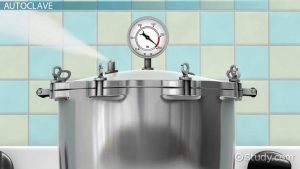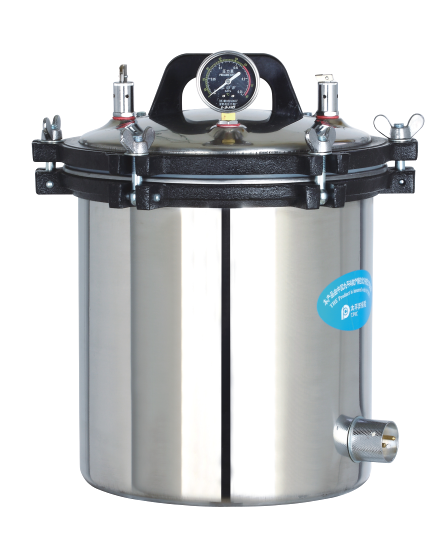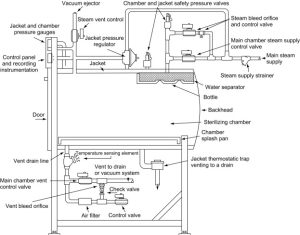AUTOCLAVE
Autoclave
It is a machine used to sterilize by killing bacteria, viruses in the material placed inside.
Sterilization is the complete removal of micro organisms from an object or surface, it is obtained when micro organism are subjected to anti microbial agents for sufficient time and at optimum conditions.
Physical methods of sterilization
A) Heat sterilization which consist of moist heat and dry heat sterilization
B) Filtration which consist of irradiation
C) Sound (sonic) waves which consist of Pressure and Sunlight
An autoclave is also known as a steam sterilizer. Moist heat is the most common and effective method of sterilization

Parts of an autoclave
1. Pressure chamber
2. Lid/door
3. Bolt
4. Wing nut
5. Gasket
6. Container
7. Sterilizing drum
8. Sieve plate
Lid Consist of:
A) Pressure gauge
B) Pressure releasing unit / whistle
C) Safety valve
Pressure chamber: It is the main component of a steam autoclave, consist of an inner chamber and outer jacket
Lid: It seals off the outside atmosphere and create a sterilized condition on the inside of the autoclave, it is made tight via screw clamp and asbestos washer.
Pressure gauge: It assures the safety of the autoclave.
Whistle: It controls the pressure inside the chamber by releasing a certain amount of vapor by lifting itself
Safety Valve: It has a thin layer of rubber that bursts itself to release the pressure and avoid the danger of explosion.
Working Principle
- The autoclave works on the principle of moist heat sterilization where steam under pressure is used to sterilize the material present inside the chamber.
- The high pressure increases the boiling point of water and thus helps achieve a higher temperature for sterilization.
- Water usually boils at 100°C under normal atmospheric pressure (760 mm of Hg); however, the boiling point of water increases if the pressure is to be increased.
- Similarly, the high pressure also facilitates the rapid penetration of heat into deeper parts of the material, and moisture present in the steam causes the coagulation of proteins causing an irreversible loss of function and activity of microbes.
- This principle is employed in an autoclave where the water boils at 121°C at the pressure of 15 psi or 775 mm of Hg.
- When this steam comes in contact on the surface, it kills the microbes by giving off latent heat.
- The condensed liquid ensures the moist killing of the microbes.
- Once the sterilization phase is completed (which depends on the level of contamination of material inside), the pressure is released from the inside of the chamber through the whistle.
- The pressure inside the chamber is then restored back to ambient pressure while the components inside remain hot for some time.
Precaution of using an Autoclave
* Autoclaves should not be used to sterilize water-proof or water-resistant substances like oil or powders.
* The autoclave should not be overcrowded, and the materials should be loaded in a way that ensures sufficient penetration of articles by the steam.
* Items to be autoclaved should always be placed in a secondary container.
* Only autoclavable bags are to be used to autoclave packaged waste.
* To ensure sufficient penetration, articles should be wrapped in something that allows penetration by steam, and materials like aluminum foils should not be used.
* The items placed inside the chamber should not touch the sides or top of the chamber.
* The wastes and clean items should be autoclaved separately.
* Attempts to open the lid when the autoclave is working should never be made.
* Liquid components should never be autoclaved in sealed containers.
* The liquid inside the containers should only be filled 2/3rd of the total volume to prevent the spilling of the liquid.
* Plastic or polyethylene trays or containers should not be used as they might melt and damage the autoclave.
* Besides, never autoclave flammable, reactive, corrosive, toxic or radioactive materials, household bleach, or paraffin-embedded tissue.
* The paper should not be placed directly inside an autoclave as it is a combustible substance. It should be autoclaved in a waste bag on a bio bag setting to prevent fire.


